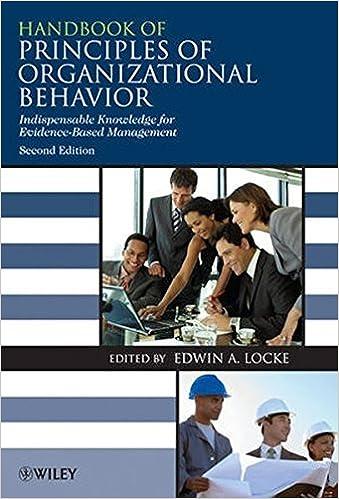The purpose of this exercise is to allow students to think about the sort of organizational work
Question:
The purpose of this exercise is to allow students to think about the sort of organizational work environment that they should seek (or create) for their future career moves, if they wish to optimize their own opportunities for creative work. It takes about 30 – 45 minutes, depending on how much time you allocate for discussion.
In this exercise, students will rate how important various aspects of their work environment are for their own personal creativity. For that reason, the exercise is most appropriate after you have taught them about how various aspects of the work environment can facilitate or impede creativity. Begin the exercise by asking them to reflect for a few moments on their prior work experiences (or school - work experiences, if they have not yet held jobs). They should try to recall, in detail, one or two instances in which they did truly creative work, and think about the work environment surrounding them in those instances. Then they should recall, in detail, one or two instances in which their creativity was blocked, and think about the work environment surrounding them in those instances.
Next, tell them that they will generalize from these instances (and others like them) to the future work environments that might best support their own creativity. On a sheet of paper (ideally, a form that you have prepared for them in advance), have students privately indicate whether they would like to HAVE or AVOID the following features of the work environment. Then, they should indicate whether each of those features is VERY IMPORTANT to them, SOMEWHAT IMPORTANT to them, or LESS IMPORTANT to them. Remind them that they will likely have to make tradeoffs, that it is unrealistic to rate everything as VERY IMPORTANT. This first part of the exercise (remembering specific instances and then completing the form individually) generally takes about 15 minutes.
1. Freedom in deciding what work to do or how to do it.
2. A sense of challenge in your work – working hard on challenging or important projects.
3. Sufficient resources – including funds, materials, and information – to accomplish the work.
4. Supervisory encouragement from a good work model who sets goals appropriately, supports the workgroup, values individual contributions, and shows confidence in the workgroup.
5. Workgroup supports from people who are diversely skilled, communicate well, are open to new ideas, constructively challenge each other ’s work, trust and help each other, and feel committed to the work they are doing.
6. Organizational encouragement that promotes the fair, constructive judgment of ideas, rewards and recognizes people for creative work, helps foster an active flow of new ideas, and maintains a shared vision of what the organization is trying to do.
7. Organizational impediments, including internal political problems, harsh criticism of new ideas, destructive internal competition, an avoidance of risk, and an overemphasis on the status quo.
8. Workload pressure, such as extreme time pressures, unrealistic expectations for productivity, or distractions from creative work.
After students have indicated whether they would like to HAVE or AVOID each feature of the work environment, and how important the features are to them, have them brainstorm (in pairs or small groups) ways in which they can find or create their ideal work environments. Have them consider the following questions:
What sorts of companies and industries should you look for? What sorts of companies and industries should you avoid? What can you do to proactively create your ideal work environment? If there is time, you may wish to continue with a whole - group discussion in which students share some of the insights they developed through the individual exercise and the small - group discussions. This exercise will help students identify those few key features that deserve most of their attention as they look for jobs or think about establishing their own work environments.
Step by Step Answer:






